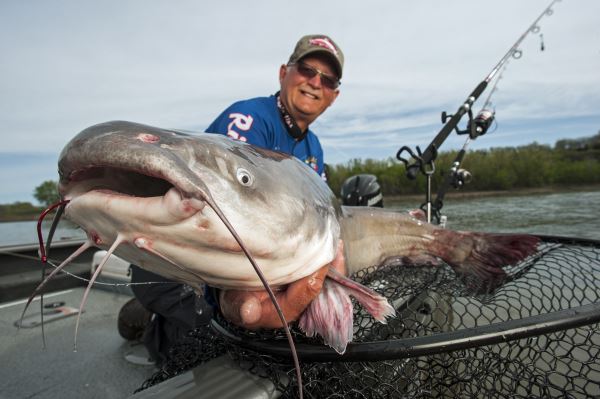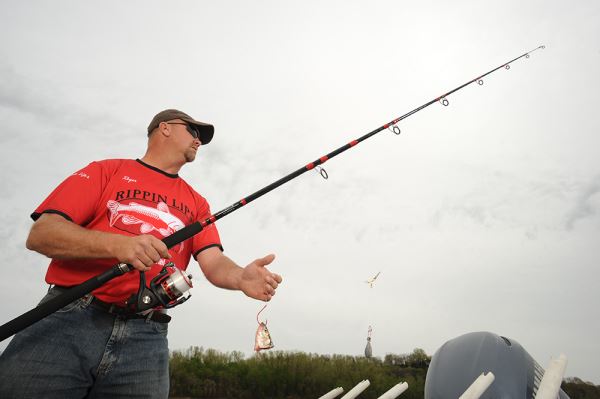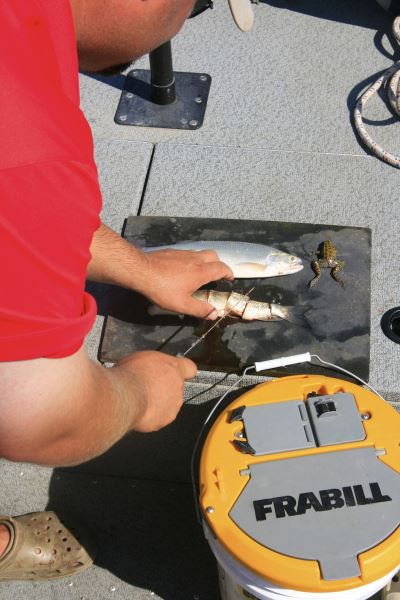According to a recent study of licensed anglers by the U.S. Fish & Wildlife Service, some 7 million US fishermen and women claimed catfish to be their favorite target. That’s fewer than the 10 million anglers who choose to chase black bass – which is ten times the number of anglers who said walleyes are their primary focus. America’s love affair with catfish goes way back, with reports of 200- and 300-pound blue cats caught during the early 19th century. Mark Twain revered cats too, frequently romanticizing the species in print, and once writing of “a Mississippi River catfish that was more than 6 feet long.”
 These days, hot fishing for big channel cats is in range of just about any interested angler. Their abundance and potential size are just two among many reasons for the popularity of the bottom feeders. Another reason for attempting a late-summer catfish adventure: there are as many ways to catch them as there are cupholders on your current deck or pontoon boat.
These days, hot fishing for big channel cats is in range of just about any interested angler. Their abundance and potential size are just two among many reasons for the popularity of the bottom feeders. Another reason for attempting a late-summer catfish adventure: there are as many ways to catch them as there are cupholders on your current deck or pontoon boat.
One of the region’s most successful catfish fishing guides, Brad Durick works the waters of the Red River, which is famous for its huge channel cats and rather bizarre 550-mile south-to-north flow. Originating at the confluence of the Bois de Sioux and Otter Tail rivers between Minnesota and North Dakota, the Red River flows northward through the Red River Valley, forming most of the border between the two states and continuing into Manitoba, where it empties into Lake Winnipeg.
The Red River channel cats Durick hunts daily, from May through October, are some of the largest on the planet. According to the fishing guide, simple three-way or Carolina-style rigging and fresh cutbait are key ingredients to successful catfishing in the Red or any other water system that offers a little flow and holds a healthy population of channel cats.
By mid-summer, water flows have stabilized and catfish have fully finished spawning and movement patterns become predictable. While most anglers during this time continue focusing on obvious fishing spots, such as visible wood snags, rockpiles, deep holes or dams, Durick has a quiver of prime catfish spots to himself.
“Everything I do relates to current,” says the Coast Guard licensed captain. “The best thing catfish anglers can do for themselves is learn to read the water. Every key change in the river bottom is revealed by things happening on the surface.
 “Catfish flock to current seams—where two currents come together. On the surface, it’s often a subtle sign. But once you know what it looks like, seams are as obvious as a downed oak tree. Current breaks and their underlying topography are incredibly overlooked, but they have everything a catfish needs—a break from current, oxygen, and of course food.”
“Catfish flock to current seams—where two currents come together. On the surface, it’s often a subtle sign. But once you know what it looks like, seams are as obvious as a downed oak tree. Current breaks and their underlying topography are incredibly overlooked, but they have everything a catfish needs—a break from current, oxygen, and of course food.”
Durick says that while a big gnarly woodpile might look great, if it lies out of the main flow, anglers will struggle to catch catfish there. Conversely, even a small bush or a subtle hole can gather multiple whopper catfish—if it’s associated with substantial current. One of Durick’s better midsummer spots is a 4- to 10-foot trench cut into the outside of a river bend. His best troughs are often the shallowest ones.
“I really like 3- to 4-foot holes with a trough-like effect. Food is dropping into these spots all the time. And even though there might be strong current flowing into it, there are always areas of reduced water flow where cats can hold and wait for food.”
Associated overlooked summer spots, Durick says, are small holes near a shoreline break, especially those with current seams running along their edges. In higher water years, he’s also had great fishing below dams all through summer.
In each instance, Durick baits with Carolina style rigs—a 2- to 5-ounce No-Roll sinker above a ball bearing swivel and a 10-inch leader of 30-pound test mono snelled to a 4/0 to 8/0 circle hook, depending on bait size and how catfish are striking. He prefers circle hooks by Rippin Lips and Bottom Dwellers Tackle. In heavier current, Durick says big cats routinely grab a bait and run aggressively, necessitating wider gap (larger size) hooks and shorter snells.
 “Most of the time, I use suckers cut into small ‘steaks,’” offers Durick. “They’re abundant, inexpensive and catfish gobble ‘em up.” When available, Durick also uses wild goldeye, fresh from the river. In wetter years, particularly during August and September, leopard frogs emerge en masse. The late summer frog bite can be exceptional, but prevailing dry weather sometimes eliminates this amphibious pattern.
“Most of the time, I use suckers cut into small ‘steaks,’” offers Durick. “They’re abundant, inexpensive and catfish gobble ‘em up.” When available, Durick also uses wild goldeye, fresh from the river. In wetter years, particularly during August and September, leopard frogs emerge en masse. The late summer frog bite can be exceptional, but prevailing dry weather sometimes eliminates this amphibious pattern.
Durick adds another observation about extra warm water. “In the hottest summer weather, for whatever reason, catfish often prefer to bite frozen bait over fresh cut specimens. I think maybe warmer water pulls the blood and oils out of fresh bait faster than frozen stuff. Regardless, I’ve found that marinating or dowsing my cutbaits in an attractant called Scent Trail has significantly increased my bites. It’s powerful stuff.”
In most spots, Durick employs a special 20-pound Cat River Anchor, which he says holds in any type of bottom. That said, he rarely sits in a single spot for more than 15 minutes, unless he’s fishing after a front, or after a drop in water temperature, which slows catfish activity. Which is all the more reason to anchor-up, bait up, and relax for the long haul – one of the perks of summer catfishing wherever you wet a line.

